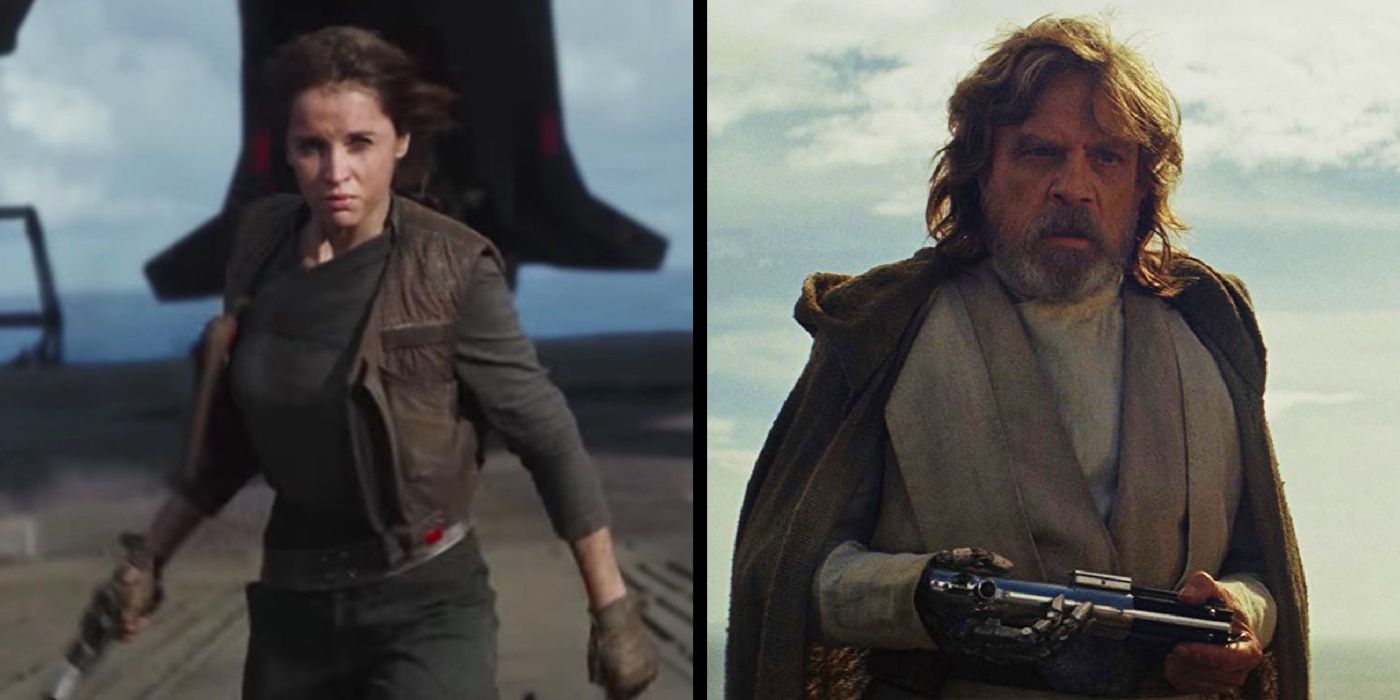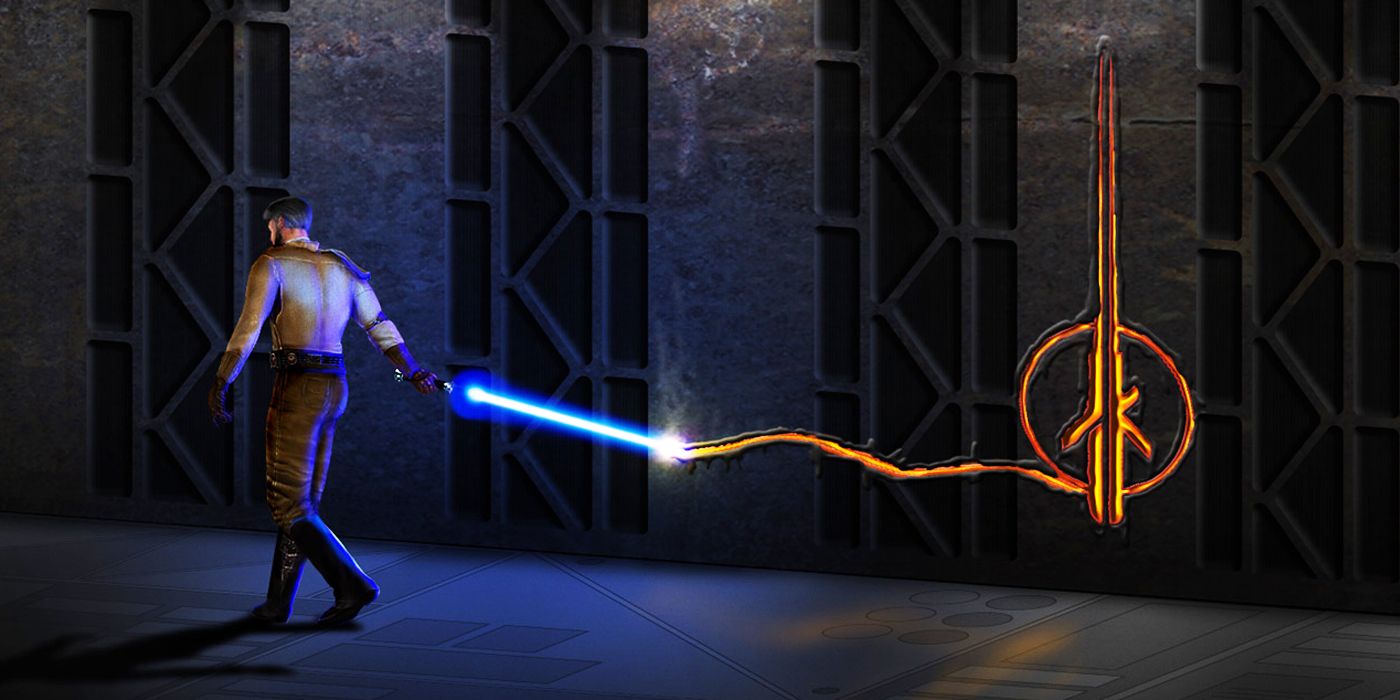
Star Wars canon has left many Expanded Universe characters, including gaming legend Kyle Katarn, without a place in the modern franchise. There was a time when Katarn was a Star Wars mainstay, appearing in eight video games over a little over a decade, but as the franchise moved into the new Disney era, he's been left behind. With his greatest adventure, Jedi Knight II: Jedi Outcast, now getting a reprive on Nintendo Switch and PS4, is there hope for the Rebel-turned-Jedi?
The situation with Star Wars canon is, at this point, well-documented. In 2014, less than two years after their purchase of Lucasfilm, Disney reset the galaxy far, far away to just include the six original movies and The Clone Wars; every other book, comic, game or TV holiday special in the Expanded Universe became the non-canon Legends. This allowed the sequel trilogy movies to tell exciting new stories without tip-toeing around Yuuzhan Vong or the toys of many Skywalker-Solo children, and got rid of a lot of the complicated retcons and eye-rolling fan service that came to define the EU.
While some still grumble about the wealth of adventures that "never happened", Disney's Star Wars canon has proven more fluid than the total reset some initially feared. Many aspects have returned spiritually (Kylo Ren is a clear Jacen Solo analog), while beloved Expanded Universe characters have had a whole new lease of life - most overtly with Thrawn in Rebels, but The Mandalorian is even bringing in aspects of the infamous Holiday Special. This means that, as much as the galaxy post-Return of the Jedi is different to what storytellers imagined for decades, many of those beloved faces can still appear.
Regrettably, that ruling doesn't hold true for Kyle Katarn. While all of his stories are readily available thanks to Steam (and the aforementioned Jedi Outcast console rerelease), their relevancy to Star Wars canon has long since passed. And, perhaps, that's a good thing.

Kyle Katarn is, without much competition, the biggest Star Wars gaming character that has ever existed. Yes, Knights of the Old Republic's Darth Revan is the subject of a massive twist with millennia-reaching ramifications and The Force Unleashed's Starkiller greatly deepened Darth Vader (both story events are now Legends), but this smuggler was the star of the primo Star Wars FPS series who helped define a transitional era for the franchise.
And what a story those games told. Kyle was introduced in Dark Forces as a grouchy former Imperial who helps the Rebels steal plans to a moon-sized superweapon the Empire has developed, and later undoing the robotic Dark trooper development project (running foul of Jabba the Hutt on his way). Years later in Dark Forces II: Jedi Knight, when the burgeoning New Republic was threated by Jerec, the Dark Jedi who murdered Kyle's father, he discovered his innate Force ability, going on to train former Emperor's Hand Mara Jade and flirt with the dark himself before redemption in expansion Mysteries of the Sith. Kyle eventually re-embraced his Force abilities to stop another Dark Jedi (this time with support from Lando) in Jedi Knight II: Jedi Outcast, before taking up an NPC job alongside Mara's husband, Luke Skywalker, in Jedi Academy.
While that may be on paper a fan-pleasing fantasy of Han Solo with a lightsaber who rubs shoulders with the galaxy's best, Katarn sidestepped of a lot of the conventional Expanded Universe pitfalls thanks to his medium. Playing through his eyes (at least until Jedi Outcast's lightsaber forced third-person combat) in full 3D put fans in Star Wars like never before, able to interact and shape the world (the alternate ending to Dark Forces II, unlockable by killing of civilians during the first half of the game, even saw Kyle take over the galaxy as a new Emperor).
The timing of all this can't be understated. Dark Forces released 1995, at the birth of the FPS genre (Kyle was the first character able to jump), bringing Star Wars to the pinnacle of gaming tech. Its sequel in 1997 used real actors in a live-action/CG hybrid decades before motion-capture brought actors into video games, providing the first performed Star Wars story since Ewoks: The Battle for Endor over a decade earlier. Its expansion then connected directly to the well-established novels by including Mara. And when Kyle Katarn returned four years later in 2002's Jedi Outcast, he melded prequel trilogy Force and lightsaber skills (still a watermark for all Star Wars gaming) with the familiar locales and characters of the original trilogy.

Of course, even with just a passing awareness of the new Star Wars canon Disney has been rampantly expanding over the past five years makes clear that Kyle Katarn has little place. Most obviously, his introductory role in stealing the Death Star plans (itself already substantially retconned to fit into the Expanded Universe's many other tellings of the opening crawl) has been replaced in popular culture by billion-dollar spinoff Rogue One: A Star Wars Story.
But it goes beyond that. Kyle's relationship with Mara Jade, something that defines his flirtation to the dark, is null and void given that the Emperor's Hand herself can't reasonably exist in any recognizable form; even if the Inquisitors hadn't become Palpatine's canon Force-servants of choice, she can no longer end up married to Luke Skywalker, whose closest hint of romance came in a dream at the start of Star Wars: The Last Jedi's novelization. That movie's more removed Luke also means Kyle can't gain any formal training or get his Jedi Academy payoff.
Star Wars canon has noticeably avoid several big areas of the timeline that Legends trod. Knights of the Old Republic is a mystery beyond the broad strokes of Rule of Two creator Darth Bane, while very little of what happened between The Empire Strikes Back and Return of the Jedi (the setting for 1996's multimedia project Shadows of the Empire). Even whether Boba Fett escapes the Sarlacc or not remains undefined. Lucasfilm under Disney is aware of the big events in Star Wars history and what needs the right story to fill. Unfortunately, the life of Kyle Katarn - be it the Death Star plans, his work with Mara Jade, or time at Luke's Jedi Academy - is not one of them.

At this point, it feels like a matter of time until Kyle Katarn gets a special episode on Dave Filoni animation, a name-drop in a Disney+ show, or a teasing character description in a novel. Re-canonization is the backbone of Disney Star Wars' fan-service. Even Kyle's fellow Han-alike Dash Rendar, who Rogue One writer Gary Whitta once stated would be unlikely to ever return, has been made Star Wars canon, albeit in a passing way that doesn't promise further adventures.
But what good can it do? There's definitely intrigue in the prospect of seeing Kyle take up with his partner Jan Ors in the Moldy Crow (or later, Raven's Claw) once more, but when it comes to everything that made him great, he's narratively moot: anything that could define Kyle Katarn beyond a newly-written ex-Imperial scoundrel-done-good can't gel in the Disney galaxy.
Indeed, Kyle's future certainly doesn't seem to be in Star Wars games. Compared to the heyday of the late 1990s and early 2000s where multiple Star Wars games released every year, EA's use of the license has been spluttering at best, with just two divisive Battlefront games to their name. Next year brings Jedi: Fallen Order, but it appears to be much more in the vein of 2009's The Force Unleashed meshed with Uncharted (all focus on action-adventure, with basic power-up Force powers and a lightsaber that functions more like a glowing baton). There's no space for the single-player story of a smuggler, especially after both 1313 and Visceral's open-world game were canceled. And if it's not in a video game, does Katarn really connect to those who like him so much?
Ultimately, Kyle Katarn feels like he belongs to a different era of Star Wars. Perhaps not of the pre-Phantom Menace times given how well Jedi Outcast adapted to the shifting expectations of the prequels, but certainly of what Star Wars before Revenge of the Sith brought it to an "end" (not the first or last time that phrase was used). His games may hold up well enough to get a proper rerelease in 2019, but their real importance is to what the saga was, not what it is or will be. Kyle Katarn is a relic of an old time. But an awesome one.
from ScreenRant - Feed https://ift.tt/2mqJfn4


0 Comments